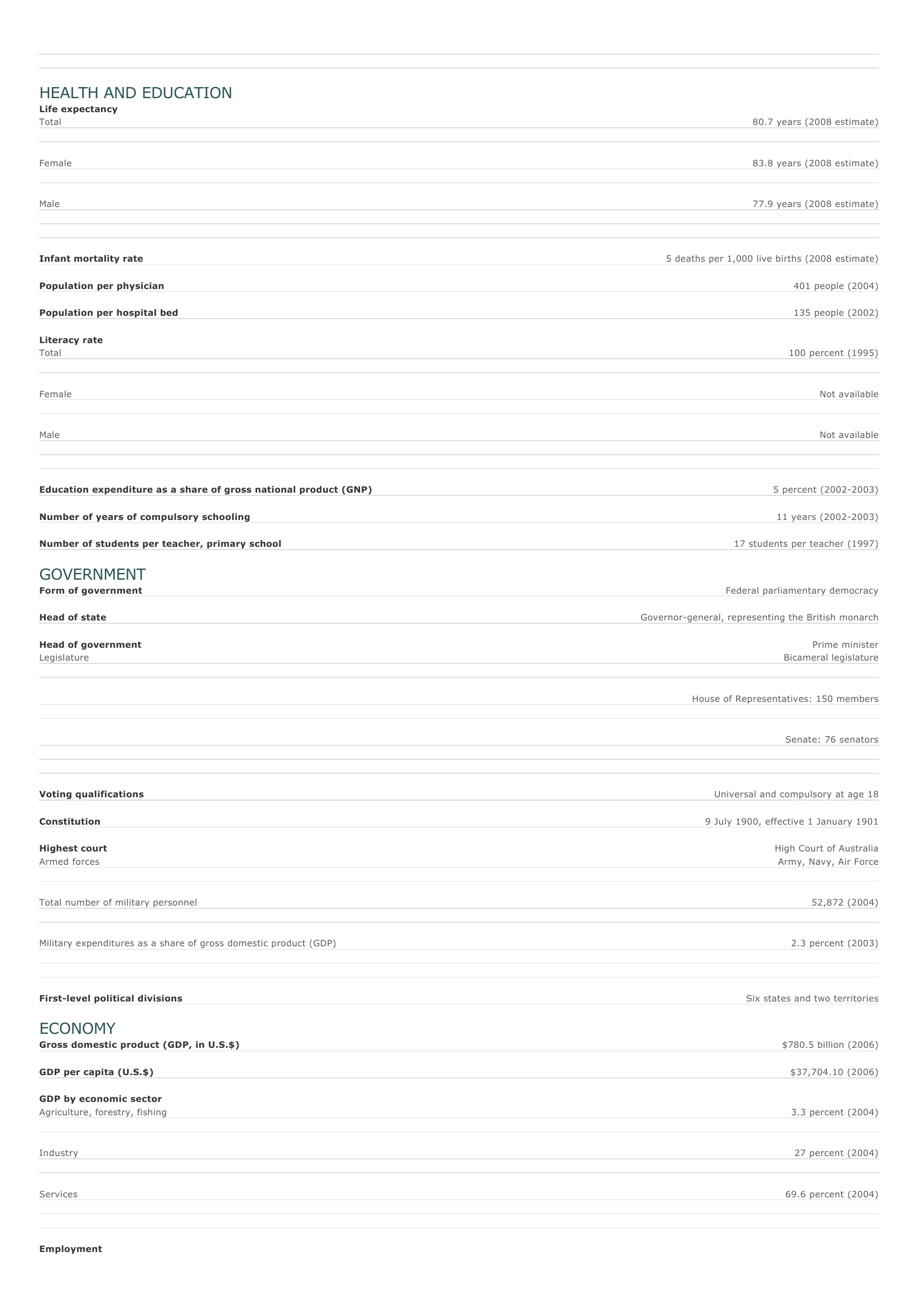Australia Facts and Figures. BASIC FACTS Official name Capital Area Commonwealth of Australia Canberra 7,682,300 sq km 2,966,200 sq mi PEOPLE Population 20,600,856 (2008 estimate) Population growth Population growth rate 0.80 percent (2008 estimate) Projected population in 2025 23,022,980 (2025 estimate) Projected population in 2050 24,175,783 (2050 estimate) Population density Urban/rural distribution Share urban Share rural 2.7 persons per sq km (2008 estimate) 7 persons per sq mi (2008 estimate) 93 percent (2005 estimate) 7 percent (2005 estimate) Largest cities, with population S ydney 4,119,190 (2006) Melbourne 3,592,591 (2006) Brisbane 1,763,131 (2006) P erth 1,445,078 (2006) Adelaide 1,105,839 (2006) Ethnic groups White 91 percent Asian 7 percent Aboriginal and other 2 percent Languages English (official), indigenous languages Religious affiliations Roman Catholic 29 percent Anglican 22 percent Protestants 14 percent Other Christian 15 percent nonreligious 14 percent O ther 6 percent HEALTH AND EDUCATION Life expectancy Total 80.7 years (2008 estimate) Female 83.8 years (2008 estimate) Male 77.9 years (2008 estimate) Infant mortality rate 5 deaths per 1,000 live births (2008 estimate) Population per physician 401 people (2004) Population per hospital bed 135 people (2002) Literacy rate Total 100 percent (1995) Female Not available Male Not available Education expenditure as a share of gross national product (GNP) Number of years of compulsory schooling Number of students per teacher, primary school 5 percent (2002-2003) 11 years (2002-2003) 17 students per teacher (1997) GOVERNMENT Form of government Head of state Head of government Legislature Federal parliamentary democracy Governor-general, representing the British monarch Prime minister Bicameral legislature House of Representatives: 150 members Senate: 76 senators Voting qualifications Constitution Highest court Armed forces Total number of military personnel Military expenditures as a share of gross domestic product (GDP) First-level political divisions Universal and compulsory at age 18 9 July 1900, effective 1 January 1901 High Court of Australia Army, Navy, Air Force 52,872 (2004) 2.3 percent (2003) Six states and two territories ECONOMY Gross domestic product (GDP, in U.S.$) $780.5 billion (2006) GDP per capita (U.S.$) $37,704.10 (2006) GDP by economic sector Agriculture, forestry, fishing 3.3 percent (2004) I ndustry 27 percent (2004) Services 69.6 percent (2004) Employment Number of workers 10,527,217 (2006) Workforce share of economic sector Agriculture, forestry, fishing 4 percent (2005) I ndustry 21 percent (2005) Services 75 percent (2005) Unemployment rate 5.4 percent (2004) National budget (U.S.$) Total revenue $202,795 million (2006) Total expenditure $188,614 million (2006) Monetary unit 1 Australian dollar ($A), consisting of 100 cents Agriculture Wheat and other grains, wool, beef, vegetables, fruits, cotton, sugarcane Mining Coal, bauxite, alumina, iron ore, gold, silver, diamonds, petroleum, natural gas, zinc, copper, manganese, titanium, nickel, tin, lead, uranium, zircon, tungsten Manufacturing Metals and metal products, food products, transportation equipment, machinery, chemicals and chemical products, textiles and clothing, wood and paper products, printed materials Major exports Metal ores, coal, gold, nonferrous metals, meat and meat products, textile fibers, petroleum and petroleum products, cereals Major imports Road vehicles and other transportation equipment, machinery, office equipment, petroleum and petroleum products, textiles Major trade partners for exports Japan, United States, South Korea, China, New Zealand Major trade partners for imports United States, Japan, China, Germany, United Kingdom ENERGY, COMMUNICATIONS, AND TRANSPORTATION Electricity production Electricity from thermal sources Electricity from hydroelectric sources Electricity from nuclear sources Electricity from geothermal, solar, and wind sources Number of radios per 1,000 people 91.36 percent (2003 estimate) 7.37 percent (2003 estimate) 0 percent (2003 estimate) 1.27 percent (2003 estimate) 1,931 (2000 estimate) Number of telephones per 1,000 people 564 (2005) Number of televisions per 1,000 people 746 (2000 estimate) Number of Internet hosts per 10,000 people 1,428 (2003) Daily newspaper circulation per 1,000 people 297 (1996) Number of motor vehicles per 1,000 people 601 (1997) Paved road as a share of total roads SOURCES Basic Facts and People sections 39 percent (1998) Area data are from the statistical bureaus of individual countries. Population, population growth rate, and population projections are from the United States Census Bureau, International Programs Center, International Data Base (IDB) (www.census.gov). Urban and rural population data are from the Food and Agriculture Organization (FAO) of the United Nations (UN), FAOSTAT database (www.fao.org). Largest cities population data and political divisions data are from the statistical bureaus of individual countries. Ethnic divisions and religion data are largely from the latest Central Intelligence Agency (CIA) World Factbook and from various country censuses and reports. Language data are largely from the Ethnologue, Languages of the World, Summer Institute of Linguistics International (www.sil.org). Health and Education section Life expectancy and infant mortality data are from the United States Census Bureau, International Programs Center, International database (IDB) (www.census.gov). Population per physician and population per hospital bed data are from the World Health Organization (WHO) (www.who.int). Education data are from the United Nations Educational, Scientific and Cultural Organization (UNESCO) database (www.unesco.org). Government section Government, independence, legislature, constitution, highest court, and voting qualifications data are largely from various government Web sites, the latest Europa World Yearbook, and the latest Central Intelligence Agency (CIA) World Factbook. The armed forces data is from Military Balance. Economy section Gross domestic product (GDP), GDP per capita, GDP by economic sectors, employment, and national budget data are from the World Bank database (www.worldbank.org). Monetary unit, agriculture, mining, manufacturing, exports, imports, and major trade partner information is from the statistical bureaus of individual countries, latest Europa World Yearbook, and various United Nations and International Monetary Fund (IMF) publications. Energy, Communication, and Transportation section Electricity information is from the Energy Information Administration (EIA) database (www.eia.doe.gov). Radio, telephone, television, and newspaper information is from the United Nations Educational, Scientific and Cultural Organization (UNESCO) database (www.unesco.org). Internet hosts, motor vehicles, and road data are from the World Bank database (www.worldbank.org). Note Figures may not total 100 percent due to rounding. Microsoft ® Encarta ® 2009. © 1993-2008 Microsoft Corporation. All rights reserved.










